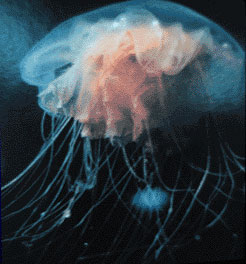As the globe is covered with 2/3rd sea, a fascinating world beneath there is always arouse the curiosity of mankind. The species living there having the history of dates back that of humans. Such creatures are voluminous and their features and appearance are beyond our imagination.Here are the fascinating few.
A Ping-Pong tree sponge
A fan-fin sea devil
A kind of octopus
Scientists call this a Dumbo Octopus with fins. Researchers from the Monterrey Bay Aquarium Research Institute find these creatures close to the bottom of the ocean floor, miles below the surface. They are studying them but have not yet figured out their behavior patterns or biology. The largest specimens are almost five feet tall.
Crystal jellies
Otherwise called aequorea, are found in Monterey Bay but are more common in coastal waters further north. The rim of their bells glows with a green fluorescent(biolumescent) protein.
Deepstaria
Deepstaria enigmatica always seems to have an isopod living inside it. Isopods are small crustaceous creatures. Not all are parasites. Pill bugs are a form of isopod. Deepstaria are very slow swimmers, and have no tentacles to capture prey. Instead, they simply close their large flexible bells over their food.
Crown Jellyfish
As a species jellies have been around the sea for a very long time. It is found that they appeared in the oceans about 650 million years ago, before the dinosaurs. Jellyfish are incredible and amazing creatures as their bodies are made up of 95% water, have no bones or cartilage, no heart or blood, and no brain!. They are one of earth's simpler and more primitive life forms. The picture is a smaller specimen called "lion's mane jelly".
Here is an another kind of jellyfish named "cyanea-capillata"
Have you found a snorkel to go out and see for yourself?
Saturday, March 15, 2008
UNDERSEA SPECIES
Posted by gkrishnan at 5:46 AM 0 comments
Labels: undersea species
Tuesday, March 11, 2008
China Yangtze Three Gorges Project (TGP)
The Three Gorges Dam claimed the name as the world’s most notorious dam is being built across Yangtze River. Mr. Sun Yat Sen, the founder of Chinese Republic, first proposed the project in 1919. The primary aims of the dam are to alleviate flooding on the Yangtze River and generate power. It was hailed as one of the engineering feats of the 20th century. The dam is located in the areas of Xilingxia gorge, one of the three gorges of the river, which will control a drainage area of 1 million km square, with an average annual runoff of 451 billion m3. The project was begun in 1993 at an official cost of 200bn Yuan ($25bn), though unofficial estimates are far higher. It reached its final height of 185m (607 feet). Fourteen turbine generator units are already in operation. But it will not be fully operational until 2009.It is claimed by Chinese that the dam’s power generation potential is the equivalent of burning 50 million tons of coal or 25 million tons of crude oil.
The project sketch

Vessels emerge from the five-stage permanent ship lock, illustrating the immense scale of the project

When the dam's reservoir reaches its final height of 175m, scheduled for 2009, the five-chamber ship lock will raise boats by as much as 113m.

Now the Three Gorges Dam across China’s mighty Yangtze River threatens to become an environmental catastrophe. The massive project sets records for number of people displaced (at least 1.3 million), number of cities and towns flooded (13 cities, 140 towns, 1,350 villages), and length of reservoir (more than 600 kilometers).
Has the Chinese government struck the right balance with the Three Gorges Dam? Read more about the controversy and decide for yourself.
Posted by gkrishnan at 4:14 AM 0 comments
Labels: three gorges dam
Sunday, March 9, 2008
Roses are Blue
- A color that is known to hold universal appeal, blue plays a significant role in many cultures’ religious rituals and ceremonies. It’s said that the Western tradition of a bride wearing something blue is tied to the color’s symbolism of faithfulness and loyalty. In express trustworthiness, confidence, intelligence and unity, which explains why it’s frequently the color of police uniforms, the blue “power suit” is an icon of the business world and winners of competitions receive blue ribbons.

- Blue roses traditionally signify mystery or attaining the impossible. They are believed to be able to grant the owner youth or grant wishes. According to a Chinese folktale, the blue rose signified hope against unattainable love.

- In flowers BLUE ROSES were traditionally created by dyeing white roses, since roses lack a gene to produce delphinidin, the primary plant pigment that produces true blue flowers. On June 30, 2007 Japanese company “Suntory” and an Australian one “Florigene” announced the creation of BLUE ROSE in the world of genetical engineering, which is considered to be a holy grail of horticulturalists. The team of developers intends to continue efforts to make the roses bluer and also to consider any possible effects on other plants and the environment, with the goal of releasing this new flower commercially in 2007 or 2008.

Posted by gkrishnan at 1:39 PM 1 comments
Labels: blue rose
Subscribe to:
Posts (Atom)







